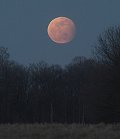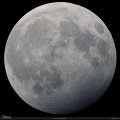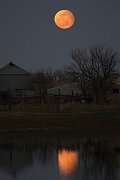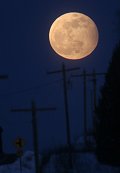
|
March 14, 2006 back to spaceweather.com |
| Summary: Earth's shadow has two parts: a dark interior called the umbra, and a pale outer fringe called the penumbra. On March 14th the penumbra fell across the Moon, producing a "penumbral lunar eclipse." Penumbral eclipses are subtle, but this one was visible as a faint but distinct shading of southern parts of the Moon: animation, visibility map. This is Page 1 | Go to Page 2 Unless otherwise stated, all images are copyrighted by the photographers. |
| Photographer, Location, Date | Larger images | Comments | |
|

|
Robert B Slobins,
La Otto, Indiana Mar. 14 |
#1 |
The moon rose when it was at mid-eclipse here in Indiana. The sky had just become totally cleared of clouds. With the moon near the horizon like this, the penumbral shading is more pronounced. Technical details: Fuji S-2 DSLR, Tamron 300/2.8 lens with 1.4X teleconverter at f/8, ISO 100, 1/10-1/30 second exposure. |
|

|
Stefan Seip,
Welzheim, near Stuttgart, Germany Mar. 14 |
#1, more |
Telescope: 13.3' Reflector telescope, f=2500mm Camera: Canon EOS 5D ISO: 100 Exposure time: 1/125 sec. I tried to conserve the visual impression while image processing. That means, not to increase the contrast, otherwise it looks like an partial eclipse. Lunar eclipses like that one are very rare: The Moon was completely (100%) covered by the Penumbra, but without hitting the Umbra. I´m very very happy that I decided not to go to the warm bed but in the cold (-8 degree C) to watch that interesting Eclipse. Even for the naked eyes the Eclipse was easy to observe--Stefan Seip |
|

|
Tom J. Martinez, Cleveland, Missouri Mar. 14 |
#1, #2, #3 | What a peaceful sight my wife and I had watching
the partially eclipsed moon rise over a neighbor's farmstead. Photo
details: Taken with a Canon Rebel 300D; Wide shot taken at 55mm f/5.6;
Medium telephoto taken at 300mm f/4; Telephoto taken at 420mm f/5.6 |
|

|
Koen van Gorp,
Boechout, Belgium Mar. 15 |
#1, more |
A very subtle display, hard to notice if you were not told, but charming nonetheless. Photo details: Canon 20D with 80mm f/5.6 apochromatic refractor, 100 ASA, 1/250s exposure. |
|

|
R.T. Smith,
Near Stoneville, NC, USA Mar. 14 |
#1, more |
No, these are not antennae of a giant insect that the recent warm weather brought, but budding tree branches. A cold blast of wind tonight reminds me it is still March. Camera Sony dsc-H1, ISO 64, f8, 1/200sec.7:07pm EST |
|

|
John Stetson,
Walker's Point, Kennebunk, ME Mar. 14 |
#1 |
... really beautiful to watch the moonrise over the water. The eclipse was already underway, and so it was possible to see the atmospheric color enhancement of the moon (on the horizon) , atmospheric distortion of the shape of the moon, and the earth's shadow (both the Belt of Venus and the earth's shadow on the moon). |
|

|
Paul M. Walsh,
Bennett, Wisconsin Mar. 14 |
#1 |
The full 'Worm Moon' was rising above the rural road in front of my house. I used a Canon 20d, with a Nikon 300mm 2.8 with a 1.6x converter. |
|

|
Ralf Vandebergh,
the Netherlands, Europe Mar. 15 |
#1 |
Here is an image of the penumbral eclipse of tonight, at the time when I'm writing this, the eclipse is going to end. 10 inch Newtonian with plossl 25mm eyepiece and Nikon Coolpix 4500 camera. |
| more images: from Jun Lao of Mason, Ohio; from Jerry Xiaojin Zhu of Madison, Wisconsin; |
